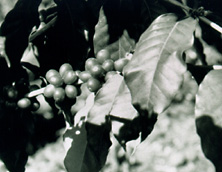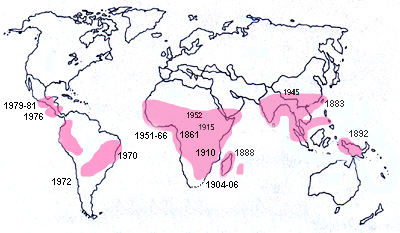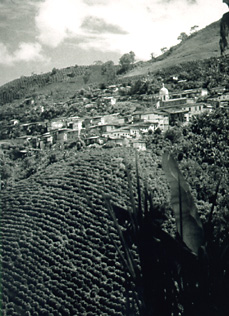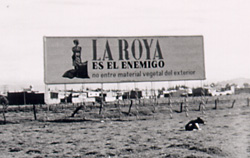Gail L. Schumann
from the book
Plant Diseases: Their Biology and Social Impact
Coffee is a crop of the tropics surpassed only by oil in its value as a world commodity. For centuries, it has been a significant import crop in Europe and economically important to the European countries that ruled tropical colonies. It remains an important crop to the independent nations created from those colonies.
Coffee became a popular drink in Europe in the 1600s when contaminated drinking water limited people to fermented beverages or those made with boiled water, such as tea or coffee. Coffee houses were major social centers in England in the 1650s. The Dutch were the first major European coffee importers, transporting coffee from their colonial plantations in Ceylon (now Sri Lanka), Java, and Sumatra.
|

Coffee with the berries that contain the seeds
or "beans" that are harvested and roasted.
|
The small, nondeciduous tree,
Coffea arabica, produces red berries that contain the seeds or beans that are roasted and then brewed into a potent caffeinated drink. The trees grow best in cool, humid climates but cannot survive frost and are thus limited to tropical highlands.
During Napoleon's time, much of the coffee-producing area was lost by the Dutch to the English. In 1825, the British began development of their property in Ceylon (now Sri Lanka), and every suitable piece of land was planted to coffee plantations. By 1870, Ceylon was the world's greatest producer of coffee.
Java remains a slang term for coffee, reflecting the time when coffee production centered in that part of the world. Today, however, 90% of the world's coffee comes from the tropical Western Hemisphere. Sri Lanka is now known best for its tea production, and the cup of tea, rather than coffee, has become a familiar part of England's culture. As with the Irish potato famine, a fungus was responsible for these changes, but only because of the agricultural practices of human beings.
The fungal parasite probably arose in southern Ethiopia, the origin of the coffee plant itself. It is a Basidiomycete, a fungal group containing many important plant parasites, and belongs to a subgroup known as the rusts. The rusts are such important plant pathogens that they are discussed in detail in Chapter 10, and the complete biology of the coffee rust fungus is explained there. It is sufficient at this point to consider the problem of a rapidly reproducing fungus capable of infecting the foliage of the coffee tree, a nondeciduous, perennial plant that grows in a frost-free climate.
|

Symptoms of coffee rust infection (Hemileia vastatrix).
|
A single tiny rust pustule on a coffee tree leaf can produce 150,000 spores, and a single leaf can contain hundreds of pustules. When the coffee rust fungus, Hemileia vastatrix, reached Ceylon in 1875, nearly 400,000 acres (160,000 hectares) were covered with coffee trees. No effective chemical fungicides were available to protect the foliage, so the fungus was able to colonize the leaves until nearly all the trees were defoliated. The spores produced on the leaves are quite resistant to desiccation, unlike the sporangia of P. infestans, and are capable of long-distance movement in a viable state. They easily moved through the acres of coffee trees, feasting on the banquet prepared by unsuspecting plantation owners. In 1870, Ceylon was exporting 100 million pounds (45 million kilograms) of coffee a year. By 1889, production was down to 5 million pounds (2.3 million kilograms). In less than 20 years, many coffee plantations were destroyed, and production had essentially ceased.

World distribution of the coffee rust fungus, with the dates it was first discovered.
|

|
H. Marshall Ward, a contemporary of Anton deBary, was sent to Ceylon by the British government to save the coffee plantations. Even though he failed, he presented the infant science of plant pathology with two important concepts that are still fundamental to plant protection. His studies of the life cycle of the rust fungus convinced him that the germinating spores represented a vulnerable stage for attack. He recommended that, to effectively protect the plant from invasion, fungicides should be present as a protective coating on the leaves before the spores arrived. Once infection had occurred, the hyphae inside the leaf tissue were no longer vulnerable to the fungicide. Thus, it was important to anticipate the disease and not to wait for symptoms to appear before spraying was initiated. Unfortunately, the sulfur fungicides of that time were neither readily available nor very effective, and the rust epidemic was too well established to save the coffee trees.
|
| Ward also warned about the dangers of monoculture. He observed that the continuous plantings of coffee trees over the island had created a perfect environment for a fungus epidemic. Rusts, like downy mildews, are obligate parasites and require living host tissue for their growth and reproduction. The rapid epidemic of the coffee rust was enhanced by the many acres of the host plant. His warnings, unfortunately, were ignored, and most of the dead coffee trees were replaced with tea bushes. Luckily, no fungus immediately invaded the tea crop, and newly discovered fungicides were soon available to protect the tea from its fungal parasites. In an attempt to escape the rust disease, coffee production moved to the Western Hemisphere. Coffee had been grown in the Caribbean Islands since the 1700s, but plantings quickly spread to the tropical highlands of Brazil, Colombia, and Central America. |

Coffee plantations on a steep hillside in Columbia. |
Today, Brazil, followed by Colombia, dominates the world coffee market. Coffee production centers in the tropical Americas because the coffee rust was successfully excluded by careful quarantines. The quarantine was successful for over 100 years, but, in 1970, coffee rust was discovered in Brazil. It is not completely clear how the fungus arrived in Brazil, but intercontinental movement of the rust spores from coffee plantations in East Africa is a likely means. The dustlike spores could also have been easily carried on luggage, people, plants, or airplanes that continuously move between the continents. Eradication of infected trees has failed to eliminate the parasite, and the fungus has slowly spread throughout the coffee-growing areas, moving into Colombia and the countries of Central America. The spread was delayed by careful quarantines between many of the countries, but political unrest and human travel, along with natural dispersal of spores by wind, have allowed the fungus to circumvent the quarantines.
|
|

Billboard near the airport of Bogata, Columbia,
waning about the danger of importing the coffee rust
fungus, before its introduction to South America.
|
What will be the consequences of the importation of such a dangerous pathogen? Frequent fungicide applications will be necessary to protect the highly susceptible cultivars of C. arabica, which produce the best quality of coffee. Chemical inputs are particularly demanding for small growers, who now must purchase fungicides and spraying equipment. Trees must be grown at lower densities to allow complete fungicide coverage of the susceptible foliage. Wider spacing of trees also increases air movement between the trees. When the foliage dries more quickly, infections are reduced since, like almost all fungal spores, rust spores require water for germination.
Chemical inputs and changes in planting practices increase the costs of production and hence the price to consumers.
Rust-resistant cultivars of C. arabica and other species such as C. canephora exist, but the crop is of poorer quality. Plant breeders must often struggle with the problem of combining desirable genetic traits for crop quality with genes for resistance in the same plant. Rust fungi are capable of producing many genetically different races, and 32 races of H. vastatrix have been detected. It is always particularly difficult to find durable resistance to a pathogen when the crop is a perennial growing in a frost-free environment. The pathogen population is not reduced by winter stresses, and replanting with new cultivars is expensive and infrequent. Resistance that is effective against all races of the parasite remains the long-term goal. In the meantime, fungicide applications are becoming part of the routine production practices on coffee plantations in the Western Hemisphere.
RETURN TO "What is Plant Pathology and Why is it Important"
RETURN TO APSnet FEATURE STORY
